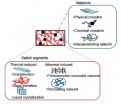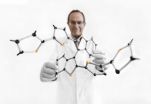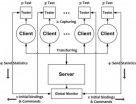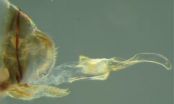(Press-News.org) An anti-malarial treatment that lost its status as the leading weapon against the deadly disease could be given a new lease of life, with new research indicating it simply needs to be administered differently.
The findings could revive the use of the cheap anti-malarial drug chloroquine in treating and preventing the mosquito-bourne disease, which claims the lives of more than half a million people each year around the world.
The parasite that causes malaria has developed resistance to chloroquine, but research carried out at the Australian National University (ANU) and Germany's University of Heidelberg has shown that the parasite protein that causes resistance has an Achilles' heel.
"We studied diverse versions of this protein and in all cases found that it is limited in its capacity to remove the drug from the parasite," said malaria researcher Dr Rowena Martin, from the ANU Research School of Biology.
"This means malaria could once again be treated with chloroquine if it is administered twice-daily, rather than just once a day".
Once hailed as a wonder drug, chloroquine is still used in developing nations in the South Pacific, Africa, Asia and South America, but has been withdrawn from use in many developed countries.
Dr Martin and her colleagues also revealed how the protein may have developed resistance to chloroquine.
"We found that the protein gains the ability to move chloroquine out of the parasite through one of two evolutionary pathways, but that this process is rigid – one wrong turn and the protein is rendered useless," she said.
"This indicates that the protein is under conflicting pressures, which is a weakness that could be exploited in future antimalarial strategies."
Dr Martin said the findings, published in the latest Proceedings of the National Academy of Sciences of the United States of America, could be used to help millions of people in developing nations who are at risk of catching malaria.
She said that there is also potential to apply the findings to several chloroquine-like drugs that are also becoming less effective as the malaria parasite builds up resistance.
Dr Martin, however, does not recommend taking large doses of chloroquine.
"The key is to increase the frequency of chloroquine administration, for example by taking a standard dose in the morning and another at night. If you take too much all at once it can kill you," she cautions.
INFORMATION: END
Scientists find new way to fight malaria drug resistance
2014-04-17
ELSE PRESS RELEASES FROM THIS DATE:
Newlyweds, be careful what you wish for
2014-04-17
A statistical analysis of the gift "fulfillments" at several hundred online wedding gift registries suggests that wedding guests are caught between a rock and a hard place when it comes to buying an appropriate gift for the happy couple. The details reported in the International Journal of Electronic Marketing and Retailing suggest that most people hope to garner social benefits of buying an expensive gift that somehow enhances their relationship with the newlyweds while at the same time they wish to limit monetary cost and save money.
Yun Kyung Oh of the Department of ...
More research called for into HIV and schistosomiasis coinfection in African children
2014-04-17
Researchers from LSTM have called for more research to be carried out into HIV and schistosomiasis coinfection in children in sub-Saharan Africa. In a paper in The Lancet Infectious Diseases LSTM's Professor Russell Stothard, working with colleagues in the department of Parasitology and researchers from Cape Western Reserve University, in Cleveland Ohio, University of Cambridge and the Royal Veterinary College looked at previous research into the joint burden of HIV/AIDS and schistosomiasis of children, and found that while disease-specific control interventions are continuing, ...
Biomedical applications of shape-memory polymers: How practically useful are they?
2014-04-17
Polymers that exhibit shape-memory effect (SME) are an important class of materials in medicine, especially for minimally invasive deployment of devices. Professor Subbu Venkatraman and his group from School of Materials Science and Engineering, Nanyang Technological University presented a review article surveying the clinical applications of the SME and addressing critically the question of its utility in implantable devices. Their work, entitled "Biomedical applications of shape-memory polymers: How practically useful are they?", was published in SCIENCE CHINA Chemistry.2014, ...
More effective kidney stone treatment, from the macroscopic to the nanoscale
2014-04-17
Researchers in France have hit on a novel method to help kidney stone sufferers ensure they receive the correct and most effective treatment possible.
Kidney stones represent a major medical problem in the western and developing world. If left untreated, apart from being particularly painful, they can lead to renal failure and other complications. In many patients treated successfully, stone recurrence is also amajor problem. Clearly a more effective pathological approach to diagnosis and treatment needs to be identified to ensure successful eradication of stones.
Worldwide ...
Structure of sodium channels different than previously believed
2014-04-17
Sodium channels are implicated in many serious conditions such as heart disease, epilepsy and pain, making them an important potential target for drug therapies. Unfortunately, there is still much scientists do not know about the molecules. New Cambridge research provides fresh and unexpected insight into the structure of sodium channels and, specifically, one of its components - β-subunit molecules - which are responsible for 'fine-tuning' the activity of the channel. The research is published in the most recent edition of the Journal of Biological Chemistry.
Nerves ...
Chiral breathing: Electrically controlled polymer changes its optical properties
2014-04-17
Electrically controlled glasses with continuously adjustable transparency, new polarisation filters, and even chemosensors capable of detecting single molecules of specific chemicals could be fabricated thanks to a new polymer unprecedentedly combining optical and electrical properties.
An international team of chemists from Italy, Germany, and Poland developed a polymer with unique optical and electric properties. Components of this polymer change their spatial configuration depending on the electric potential applied. In turn, the polarisation of transmitted light is ...
Testing protocols in Internet of Things by a formal passive technique
2014-04-17
Protocol conformance and performance testing are two branches of testing designed to determine compliance and performance of protocol implementations to their standard. Dr. CHE Xiaoping and Dr. MAAG Stephane from Laboratory UMR 5157 of French Centre national de la recherché scientifique (CNRS) focus on converging these two kinds of testing in a same formal approach. After several years of innovative research, they eventually created a formal approach to formally specify conformance and performance requirements. They successfully applied their approach on Extensible Messaging ...
New evidence of suicide epidemic among India's 'marginalized' farmers
2014-04-17
A new study has found that India's shocking rates of suicide are highest in areas with the most debt-ridden farmers who are clinging to tiny smallholdings – less than one hectare – and trying to grow 'cash crops', such as cotton and coffee, that are highly susceptible to global price fluctuations.
The research supports a range of previous case studies that point to a crisis in key areas of India's agriculture sector following the 'liberalisation' of the nation's economy during the 90s. Researchers say that policy intervention to stabilise the price of cash crops and relieve ...
Methane climate change risk suggested by proof of redox cycling of humic substances
2014-04-17
The recent Yokahama IPCC meeting painted a stark warning on the possible effects of gases such as methane – which has a greenhouse effect 32 times that of carbon dioxide. Now a team of Swiss-German researchers have shown that humic substances act as fully regenerable electron acceptors which helps explain why large amount of methane are held in wetlands instead of being released to the atmosphere. However, there are worries that if this system is disrupted it may enter into a vicious cycle to release large amounts of methane back into the atmosphere.
Wetlands, such as ...
In sex-reversed cave insects, females have the penises
2014-04-17
Researchers reporting in the Cell Press journal Current Biology on April 17 have discovered little-known cave insects with rather novel sex lives. The Brazilian insects, which represent four distinct but related species in the genus Neotrogla, are the first example of an animal with sex-reversed genitalia.
"Although sex-role reversal has been identified in several different animals, Neotrogla is the only example in which the intromittent organ is also reversed," says Kazunori Yoshizawa from Hokkaido University in Japan.
During copulation, which lasts an impressive ...




